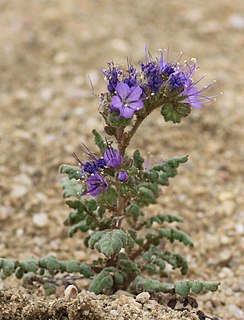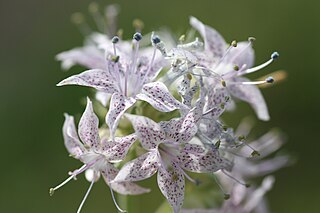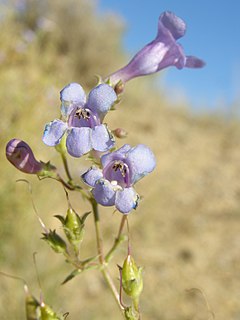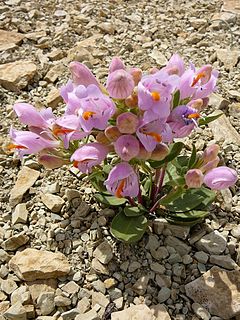Osterhout is a Dutch surname derived from Oosterhout. Variants of this name include Van Oosterhout[nb] and Van Osterhout. According to the 2010 United States Census, it ranks as the 13,330th most common name out of 160,975 last names, occurring 2288 times in the sampled data.

Astragalus jaegerianus is a rare species of milkvetch known by the common name Lane Mountain milkvetch. The plant was named for the biologist Edmund Jaeger, who first documented it in 1939.
Astragalus humillimus is a rare species of milkvetch known by the common name Mancos milkvetch. It is native to a small section of the Four Corners region of the United States, where it can be found in Montezuma County, Colorado, and San Juan County, New Mexico. There are about nine small, localized populations on sandstone rimrock ledges on the mesas. The plant occurs in a region that is being developed for oil and gas exploration, and altered by associated activities such as road construction and pipeline installation. It is a federally listed endangered species.

Astragalus osterhoutii is a rare species of milkvetch known by the common name Osterhout milkvetch. It is endemic to Grand County, Colorado, where it is known from a few populations in Middle Park, a mountain basin. There are five or six occurrences. It is a federally listed endangered species.

Phacelia formosula is a rare species of flowering plant in the borage family known by the common name North Park phacelia. It is endemic to the state of Colorado in the United States, where it is known only from the North Park region in Jackson County. It is threatened by a number of human activities, such as motorcycle and off-road vehicle use in its habitat. It is a federally listed endangered species of the United States.

Schoenocrambe argillacea is a rare species of flowering plant in the mustard family known by the common names clay reed-mustard, Uinta Basin plainsmustard, and clay thelypody.

Ipomopsis polyantha is a rare species of flowering plant in the phlox family known by the common names Pagosa ipomopsis, Pagosa skyrocket and Archuleta County standing-cypress. It is endemic to Colorado in the United States, where it occurs only in the vicinity of Pagosa Springs in Archuleta County. It is threatened by the loss of its habitat to residential and commercial development. It was federally listed as an endangered species in 2011.

Astragalus montii is a rare species of flowering plant in the legume family known by the common name heliotrope milkvetch. It is endemic to Utah in the United States, where there are only three known populations. It is a federally listed threatened species of the United States. This species is often treated as a variety of Astragalus limnocharis.

Astragalus iselyi is a rare species of flowering plant in the legume family known by the common name Isely's milkvetch. It is endemic to Utah in the United States.
Astragalus loanus is a rare species of flowering plant in the legume family known by the common name Glenwood milkvetch. It is endemic to Utah in the United States, where it occurs only in Sevier County. It is limited to volcanic gravel substrates.
Lewisia maguirei is a rare species of flowering plant in the family Montiaceae known by the common name Maguire's lewisia, or Maguire's bitterroot. It is endemic to Nevada in the United States, where it is known only from eastern Nye County.
Penstemon navajoa is a rare species of flowering plant in the plantain family known by the common name Navajo Mountain beardtongue, or Navajo beardtongue. It is endemic to Utah in the United States, where it is known only from San Juan County.

Penstemon rhizomatosus is a rare species of flowering plant in the plantain family known by the common names Scheel Creek beardtongue and rhizome beardtongue. It is endemic to Nevada in the United States, where it occurs only in the Schell Creek Range of White Pine County.
Astragalus linifolius is a species of flowering plant in the legume family known by the common name Grand Junction milkvetch. It is endemic to Colorado in the United States, where it is only found on the Uncompahgre Plateau in Delta, Mesa, and Montrose Counties. There are 21 occurrences, mostly in the general vicinity of Grand Junction.

Penstemon degeneri is a species of flowering plant in the plantain family known by the common name Degener's beardtongue. It is endemic to Colorado in the United States, where it occurs in and around the Arkansas River Canyon in Fremont, Custer, and Chaffee Counties.

Penstemon gibbensii is a species of flowering plant in the plantain family known by the common name Gibbens' beardtongue. It is native to the western United States, where it occurs in Wyoming, Colorado, and Utah.

Penstemon grahamii, known by the common names Uinta Basin beardtongue and Graham's beardtongue, is a species of flowering plant in the plantain family. It is native to Utah and Colorado in the United States.

Penstemon scariosus is a species of flowering plant in the plantain family known by the common name White River beardtongue. It is native to Colorado, Utah, and Wyoming in the United States.
Astragalus anisus is a species of flowering plant in the legume family known by the common name Gunnison milkvetch. It is endemic to Colorado in the United States, where it is limited to the Gunnison Basin of Gunnison and Saguache Counties.
Astragalus leptaleus is a species of flowering plant in the legume family known by the common name park milkvetch. It is native to the Rocky Mountains of the United States, where it occurs in Idaho, Montana, Wyoming, and Colorado.














